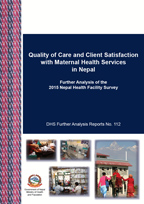- PUBLICATIONS
- JOURNAL ARTICLES
- ORDER PUBLICATIONS
Publications Summary
- Document Type
- Further Analysis
- Publication Topic(s)
- Fertility and Fertility Preferences, Health facilities/SPA surveys, Maternal Health
- Country(s)
- Nepal
- Survey
- Nepal SPA, 2015
- Language
- English
- Recommended Citation
- Acharya, S., S. Sharma, B. Dulal, and K. Aryal. 2018. Quality of Care and Client Satisfaction with Maternal Health Services in Nepal: Further Analysis of the 2015 Nepal Health Facility Survey. DHS Further Analysis Reports No. 112. Rockville, Maryland, USA: ICF.
- Download Citation
- RIS format / Text format / Endnote format
- Publication Date
- July 2018
- Publication ID
- FA112
Download
 Quality of Care and Client Satisfaction with Maternal Health Services in Nepal (PDF, 1644K)
Quality of Care and Client Satisfaction with Maternal Health Services in Nepal (PDF, 1644K)
